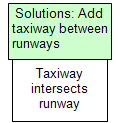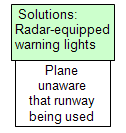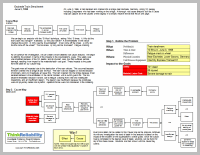On June 22, 2009, the Washington, D.C. area suffered its first fatal Metro train crash since 1982. A transit train smashed into another train that was stopped on the tracks. There has been an apparent increase in crashes in large city’s transit systems over the last several months, causing some to question whether enough is being done to ensure an attitude of safety. Robert Lauby, a former NTSB investigator, said:
“Just because you had them doesn’t mean there’s a specific issue that caused them.”
Actually, that’s exactly what it means. If something happens (an effect), there has to be a cause. Usually there’s more than one cause. We can look at this incident in a root cause analysis to determine what some of the causes were. A thorough root cause analysis built as a Cause Map can capture all of the causes in a simple, intuitive format that fits on one page.
The official investigation is still in its infant stages, but we can still put together a pretty thorough Cause Map. (See the Cause Map by clicking on “Download PDF” above.) We can add more detail to this Cause Map as the investigation continues. As with any investigation the level of detail in the analysis is based on the impact of the incident on the organization’s overall goals.
First we define the problem. Here, it’s that two trains crashed. We also enter the other identifying information (date, location and process.) Then we frame the problem with respect to the impacts to the goals. Here, the safety goal was impacted because at least 9 people were killed and at least 76 were injured. The material goal was impacted because of severe damage to the trains.
Next, we do the root cause analysis. We begin with the impacted goals and ask “why” questions to find all the causes of the incident. People were killed and injured because of the damage to the trains. The trains were damaged because of a train, which was moving at a “considerable speed” rear-ending a stopped train, and because of the inadequate crashworthiness of the moving train.
The train was not adequately crashworthy because it was old, and not replaced (despite an NTSB recommendation to replace or retrofit the older cars to increase safety in a crash). Why weren’t they replaced? We don’t know yet, but the NTSB will be talking to Metro’s administration to find out.
The two trains collided because the train that was rear-ended was stopped on the tracks, waiting for another train to move. The train that struck it did not stop or slow down. The striking train was not equipped with a data recorder and the operator was killed in the incident, so we don’t have a very good idea of what happened. But we can come up with some theories and then refine or reject them as evidence permits. Since the train didn’t stop, it’s either because there was no attempt to stop, or the braking system malfunctioned. From the information we have available, it appears that a train would not attempt to stop if the operator was unaware of the train, because she couldn’t see it and because the sensor system was not working properly, AND if the mechanical override system was not working. The sensor system not working might cause the mechanical override system to not work, OR the system could have been overridden by either the dispatcher or the operator. (Apparently having the train in manual may turn off the mechanical override.)
We can continue to add to our root cause analysis as we get more information on the accident.





